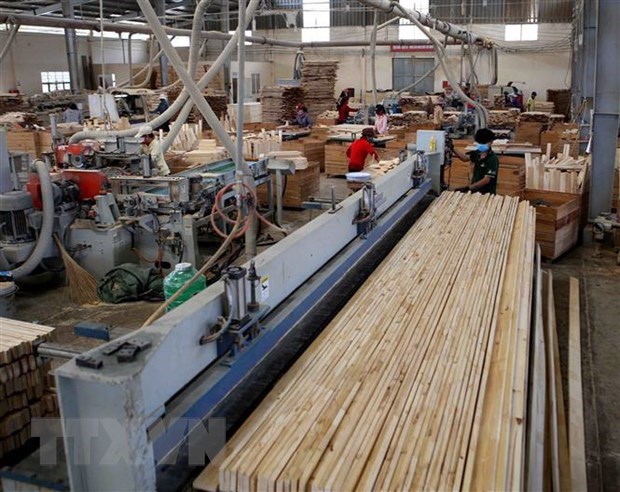CPTPP – a booster to Vietnam – Canada trade
Preferential tariff treatment under the Comprehensive and Progressive Agreement for Trans-Pacific Partnership (CPTPP) has brought in robust results to the trade in goods between Vietnam and Canada, according to insiders.

Vietnamese wood processing firms have huge opportunities to ship their products to Canada under CPTPP
The trade pact was clinched in March 2018 by 11 countries: Australia, Brunei, Canada, Chile, Japan, Malaysia, Mexico, New Zealand, Peru, Singapore and Vietnam. It came into effect in Canada in December 2018 and Vietnam in January 2019.
With the deal, Vietnam and Canada have seen substantial growth in their trade in the past two years.
According to the General Department of Customs, Vietnam shipped more than 4.36 billion USD worth of exports to Canada in 2020, up 11.47 percent from a year ago, and 44.69 percent from 2018.
Despite formidable challenges brought by COVID-19, exports to Canada surged 14.8 percent to 663.45 million USD during January-February of 2021. The figure even rose 78.67 percent as compared to the same time in 2018.
Specifically, garment and textiles brought home over 98.82 million USD, up 33.9 percent from two years ago; footwear nearly 56.35 million USD (up 57.73 percent); transport vehicles and spare parts 53.47 million USD (up 46.47 percent); machines, equipment and other parts 40.89 million USD (up 319.8 percent); fruit and vegetables nearly 4.3 million USD (up 22.48 percent); and rubber 3.27 million USD (up 227 percent).
Meanwhile, the nation splashed out 104.7 million USD on Canadian imports, including wood and wooden products, wheat, pharmaceutical products, animal feed, automobiles, computers, and electronic products, among others.
Insiders said that CPTPP left an imprint in the trade exchange between the two nations, and without COVID-19, the trade pact could have brought more benefits to the bilateral trade ties.
Australian Ambassador to Vietnam Deborah Paul said at a recent conference that CPTPP has improved the accessibility for trade and service activities between the two nations consolidated a common set of rules, reduced costs for trade activities, and helped better competitive edge of Vietnamese and Canadian products in both markets.
CPTPP establishes duty-free access for trade in goods between the two countries, while helping Vietnamese consumers purchase high-quality products from Canada at reasonable prices.
President of the Vietnam Chamber of Commerce and Industry (VCCI) Vu Tien Loc described Vietnam-Canada trade ties as one of the most successful models brought by CPTPP thanks to sustained efforts made by businesses of both countries in setting up market development rules.
The two nations have seen remarkable achievements in their import-export activities, and the trade pact plays an important role, Loc said.
Canada has abolished 94 percent of tax lines for Vietnamese exports, while the Southeast Asian country has removed nearly 66 percent of tax lines for imports from Canada. Additionally, non-tariff barriers have been improved in a transparent manner, facilitating trade flows between the two nations.
Experts said that Vietnamese firms should capitalise on tax preferences under CPTPP to boost exports to the American country.
Vietnam has huge advantages to sell products in Canada, where an increasing number of Asians are residing. Besides, the Southeast Asian country’s key products are favoured by Canadian consumers such as telephones, furniture, footwear, tea, coffee, and tropical fruits.
With CPTPP, Vietnamese products will gain price competitive edge; however, local firms need to pay due attention to improve product quality so as to establish stable foothold in this potential market./.
VNA
Vietnam, Canada enhance cooperation, connections
Vietnam, Italy seek to further expand economic, investment cooperation
Vitenam, Italy seek to further step up locality-to-locality cooperation
Vietnam, Japan work to materialise comprehensive strategic partnership
Argentina hopes to foster economic, trade, investment collaboration with Vietnam
 Seminar held to promote Vietnam - Algeria economic relations
Seminar held to promote Vietnam - Algeria economic relations
 Vietnam, France enhance transport cooperation
Vietnam, France enhance transport cooperation
 Vietnam, Singapore deepen economic, energy cooperation
Vietnam, Singapore deepen economic, energy cooperation
 Vietnam keen on expanding trade, investment cooperation with Ireland: Minister
Vietnam keen on expanding trade, investment cooperation with Ireland: Minister
 International integration drives Vietnam’s economic growth
International integration drives Vietnam’s economic growth



